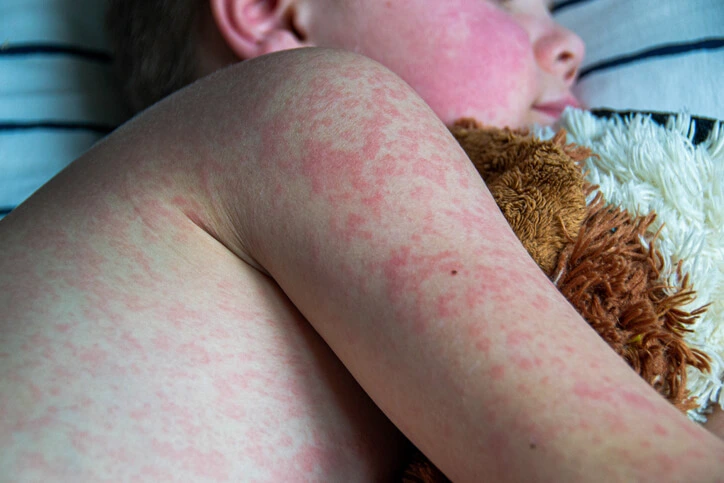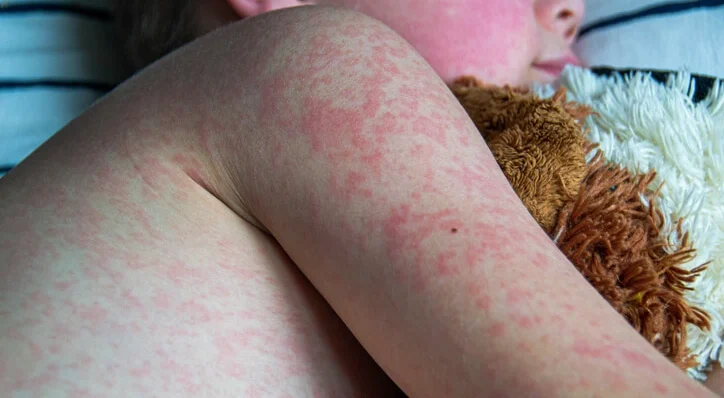Rubella, also known as German measles, is a contagious viral infection best known by its distinctive red rash. Although generally mild in children, rubella can have serious consequences if contracted by pregnant women, leading to congenital rubella syndrome (CRS) in the fetus. Rubella vaccination has dramatically reduced the incidence of the disease, yet it remains a concern in some parts of the world. Understanding rubella’s implications, particularly in the dental field, is essential for comprehensive healthcare. This article delves into the nature of rubella, its transmission, clinical features, prevention, and the crucial dental considerations associated with the disease.

Table of Contents
ToggleRubella: An Overview
Rubella is caused by the rubella virus, a member of the togavirus family. The virus is primarily spread through respiratory droplets when an infected person coughs or sneezes. It can also be transmitted from a pregnant woman to her developing fetus via the placenta. Rubella has an incubation period of about 14 to 21 days, during which the virus multiplies in the lymph nodes and subsequently spreads throughout the body.
Clinical Features
Rubella is often mild and can even go unnoticed in up to 50% of cases. When symptomatic, it typically presents with:
- Rash: A fine, pink rash that begins on the face and spreads downward to the rest of the body, lasting about three days.
- Fever: Mild fever is common, rarely exceeding 38.5°C (101.3°F).
- Lymphadenopathy: Swollen lymph nodes, especially behind the ears and at the back of the neck.
- Arthralgia and Arthritis: Joint pain and swelling, more common in adults.
- Other Symptoms: Mild conjunctivitis, sore throat, and general malaise.
In pregnant women, rubella can cross the placenta and infect the fetus, leading to CRS, which may result in severe congenital defects such as cataracts, deafness, heart defects, and developmental delays.
Rubella and Oral Health
While rubella’s primary symptoms are systemic, its impact on oral health, particularly through congenital infection, can be significant. Dental professionals must be aware of these potential effects to provide appropriate care and guidance.
Congenital Rubella Syndrome (CRS) and Oral Health
CRS can manifest various oral and dental anomalies, including:
- Enamel Hypoplasia
- Delayed Tooth Eruption
- Micrognathia
- Palatal Defects
- Gingival Hyperplasia
Enamel Hypoplasia
Defective enamel formation can result in teeth that are discolored, pitted, or have a rough surface, making them more susceptible to decay.
Delayed Tooth Eruption
Children with CRS may experience delays in the emergence of primary and permanent teeth.
Micrognathia
An abnormally small jaw, which can lead to malocclusion (misalignment of teeth).
Palatal Defects
High-arched palate or, in severe cases, cleft palate, which can affect feeding, speech, and oral hygiene.
Gingival Hyperplasia
Overgrowth of gum tissue, which can complicate dental hygiene and increase the risk of periodontal disease.
These anomalies necessitate a multidisciplinary approach involving pediatricians, dentists, orthodontists, and other specialists to manage the complex health needs of individuals with CRS.
Dental Management of Patients with Rubella
Dental professionals must be vigilant when treating patients with a history of rubella or CRS. Key considerations include:
Infection Control and Prevention
- Vaccination Status
- Standard Precautions
- Screening
Vaccination Status
Ensure that dental staff are vaccinated against rubella to prevent the spread of the virus. Patients, especially pregnant women, should also be encouraged to check their vaccination status.
Standard Precautions
Adhere to standard infection control protocols, including the use of personal protective equipment (PPE), hand hygiene, and sterilization of instruments.
Screening
Take a thorough medical history to identify patients at risk, such as those with recent exposure to rubella or pregnant women.
Dental Care for Patients with CRS
- Comprehensive Assessment
- Preventive Care
- Restorative Treatment
- Orthodontic Intervention
- Speech and Feeding Support
Comprehensive Assessment
Conduct a thorough oral examination to identify any congenital defects or dental anomalies. This includes assessing tooth eruption patterns, enamel quality, jaw structure, and palatal form.
Preventive Care
Emphasize preventive dental care, including regular cleanings, fluoride treatments, and the use of dental sealants to protect enamel.
Restorative Treatment
Address enamel hypoplasia and caries with appropriate restorative materials. In cases of severe hypoplasia, crowns or other protective restorations may be necessary.
Orthodontic Intervention
Refer patients with micrognathia or malocclusion to an orthodontist for evaluation and treatment planning.
Speech and Feeding Support
Collaborate with speech therapists and feeding specialists for patients with palatal defects to address functional challenges.
Special Considerations for Pregnant Patients
- Timing of Treatment
- Minimizing Risk
- Multidisciplinary Care
Timing of Treatment
Elective dental procedures should ideally be postponed until after pregnancy. However, necessary dental care, such as treating infections or managing pain, should not be delayed.
Minimizing Risk
Avoid exposure to rubella in the dental office by scheduling appointments when the patient is less likely to come into contact with infectious individuals.
Multidisciplinary Care
Work closely with the patient’s obstetrician and other healthcare providers to ensure coordinated care.
Prevention and Public Health Measures
- Vaccination
- Public Health Strategies
Vaccination
The primary method of preventing rubella is through vaccination with the measles, mumps, and rubella (MMR) vaccine. The vaccine is highly effective, typically given in two doses during childhood. High vaccination coverage is essential to maintain herd immunity and prevent outbreaks.
Public Health Strategies
- Education
- Surveillance
- Access to Care
Education
Public health campaigns should educate the community about the importance of vaccination, the risks of rubella, and the potential consequences of CRS.
Surveillance
Monitoring and reporting cases of rubella and CRS help public health authorities respond to outbreaks and identify areas with low vaccination coverage.
Access to Care
Ensuring access to vaccination and healthcare services, particularly in underserved communities, is crucial for preventing rubella and managing its complications.
Frequently Asked Questions (FAQs)
Is rubella the same as measles?
No, rubella (also called German measles) is different from measles (rubeola), although both cause a rash and fever. They are caused by different viruses: rubella is caused by the rubella virus, while measles is caused by the rubeola virus. Rubella symptoms are usually milder, with a shorter duration and fewer complications. However, rubella is particularly dangerous for pregnant women because it can cause severe birth defects in the unborn child (Congenital Rubella Syndrome). Measles, on the other hand, is more severe in children and can lead to pneumonia, encephalitis, and other serious complications.
How long are you contagious with rubella?
A person infected with rubella is contagious for about one week before the rash appears and remains contagious for about one week after the rash disappears. This means they can spread the virus even before showing symptoms. Rubella is transmitted through respiratory droplets (coughing or sneezing) and close contact with an infected person.
Is the rubella virus curable?
There is no specific cure for rubella, as it is a viral infection. However, symptoms usually go away on their own within a few days. Treatment focuses on relieving symptoms, such as taking fever-reducing medications, drinking plenty of fluids, and getting rest. The best way to prevent rubella is through vaccination with the MMR (measles, mumps, rubella) vaccine.
What age group is most at risk for rubella?
- Unvaccinated children under the age of 5 are at the highest risk of contracting rubella.
- Young adults and adolescents who have not been vaccinated or have not developed immunity can also be affected.
- Pregnant women who contract rubella during the first trimester are at risk of passing the infection to their unborn baby, leading to serious birth defects, including deafness, heart defects, and intellectual disabilities.
What are 5 symptoms of rubella?
The symptoms of rubella are generally mild and may include:
- Pink or red rash – It starts on the face and spreads to the rest of the body, lasting around 3 days.
- Mild fever – Usually under 102°F (38.9°C).
- Swollen lymph nodes – Especially behind the ears and in the neck.
- Sore throat – Mild irritation and discomfort when swallowing.
- Joint pain – More common in adults, especially women.
Other symptoms may include headache, runny nose, and red eyes (conjunctivitis).
Is rubella the same as chickenpox?
No, rubella and chickenpox (varicella) are different diseases caused by different viruses.
- Rubella causes a pink or red rash that is flat or slightly raised, while
- Chickenpox causes itchy, fluid-filled blisters that appear in waves across different parts of the body.
Chickenpox is caused by the varicella-zoster virus and is usually more severe, leading to complications like secondary bacterial infections, pneumonia, or shingles later in life.
Does rubella ever go away?
Yes, rubella usually resolves on its own within one to two weeks, with the rash typically disappearing within three days. However, some complications, such as arthritis-like joint pain (especially in adult women), can persist for weeks. In pregnant women, rubella can have long-term effects on the unborn baby.
What does a rubella rash look like?
The rubella rash is pink or light red, starting as small spots on the face before spreading downward to the chest, back, arms, and legs. It is usually not itchy and fades within three days, sometimes giving rubella the nickname “three-day measles.” Unlike measles, the rubella rash does not darken or peel off.
What happens physically to a person who gets rubella?
When a person contracts rubella, the virus spreads through the bloodstream and lymph nodes, leading to:
- Inflammation of the lymph nodes, especially behind the ears and in the neck.
- A mild fever and general feeling of discomfort (malaise).
- A rash that starts on the face and moves down the body.
- Possible joint pain, especially in older children and adults.
- If pregnant, the virus can cross the placenta, affecting the baby’s development and leading to Congenital Rubella Syndrome (CRS).
Who is the most common victim of rubella?
- Unvaccinated individuals are most at risk of contracting rubella.
- Pregnant women are the most vulnerable to severe consequences, as rubella can cause birth defects or even miscarriage.
- Infants born to mothers who had rubella during pregnancy may suffer from Congenital Rubella Syndrome, which can cause deafness, blindness, heart problems, and developmental delays.
Conclusion
Rubella, though largely controlled in many parts of the world, remains a public health concern with significant implications for dental care. Dental professionals must be aware of the disease’s clinical features, transmission, and prevention strategies to protect themselves and their patients. Special attention is needed for patients with CRS, as they may present with various oral and dental anomalies requiring comprehensive, multidisciplinary care. By promoting vaccination and adhering to rigorous infection control practices, dental practitioners can contribute to the prevention and management of rubella and its associated complications, ensuring better health outcomes for their patients.
Understanding the intricate relationship between systemic infections like rubella and oral health underscores the importance of integrated healthcare approaches, where dental and medical professionals collaborate to address the holistic needs of patients. Through continued education, vigilance, and public health initiatives, the dental community can play a pivotal role in mitigating the impact of rubella and enhancing overall health.

